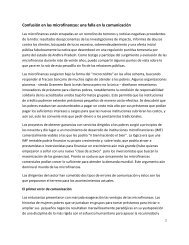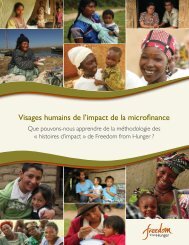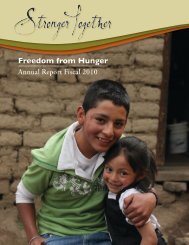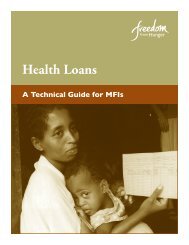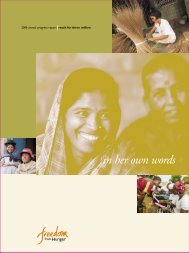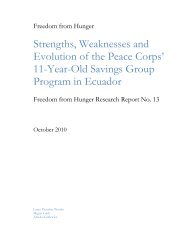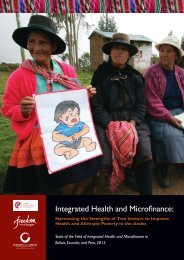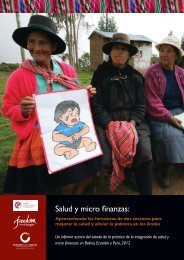history of meals for millions, soy, and freedom from ... - SoyInfo Center
history of meals for millions, soy, and freedom from ... - SoyInfo Center
history of meals for millions, soy, and freedom from ... - SoyInfo Center
You also want an ePaper? Increase the reach of your titles
YUMPU automatically turns print PDFs into web optimized ePapers that Google loves.
London: Allen & Unwin. vi + 362 p. See p. 80-87. Illust.<br />
Index. 21 cm.<br />
• Summary: This chapter, in the section titled “The<br />
Biological Sciences,” begins:<br />
“We have the tools <strong>and</strong> the technology to feed everyone<br />
in the world with our present resources. And yet its been<br />
estimated that 80 per cent <strong>of</strong> the world population normally<br />
suffers <strong>from</strong> under-nutrition or malnutrition.<br />
“One hears any number <strong>of</strong> explanations <strong>for</strong> this ironic<br />
situation–but at the bottom <strong>of</strong> them all is the simple fact that<br />
we still think <strong>of</strong> food in terms <strong>of</strong> the nineteenth century.<br />
“As long as we persist in thinking <strong>of</strong> food in terms <strong>of</strong><br />
bushels <strong>of</strong> wheat, we’ll never have enough to go around. As<br />
soon as we learn to consider food as a conveyor <strong>of</strong> essential<br />
nutrients–<strong>and</strong> look <strong>for</strong> the cheapest <strong>and</strong> best way to get<br />
these nutrients–we’ll find we have enough <strong>for</strong> all.”<br />
Today, one billion people in the world need more <strong>and</strong><br />
better proteins. “We cannot manufacture or synthesize<br />
protein.” So far as we can see, <strong>for</strong> a long time to come it<br />
will have to be grown, either as animal or vegetable protein.<br />
It is costly <strong>and</strong> inefficient to produce animal protein, which<br />
is basically a luxury; most people worldwide can af<strong>for</strong>d but<br />
little <strong>of</strong> it. Legumes are the best source <strong>of</strong> vegetable protein.<br />
We can make two basic changes which would help a<br />
great deal: (1) We should use directly, as human food, much<br />
more <strong>of</strong> the protein now grown <strong>for</strong> human consumption.<br />
Most <strong>of</strong> it is used as animal feed or thrown away. (2) We<br />
must teach processors <strong>and</strong> consumers to blend incomplete<br />
proteins so that they will cover each other’s deficiencies in<br />
essential amino acids. The resulting mixture can be<br />
supplemented in a few cases by enrichment with synthetic<br />
amino acids.<br />
As an example <strong>of</strong> these basic changes Borsook<br />
discusses briefly the development <strong>of</strong> Multi-Purpose Food,<br />
which he had a h<strong>and</strong> in developing.<br />
“The specifications which were given to me... ran<br />
somewhat as follows: Three servings were to supply the<br />
recommended Daily Allowances <strong>of</strong> protein, minerals,<br />
Vitamins A, B-1, B-2, <strong>and</strong> Niacin. The food was to be<br />
palatable, to blend readily with other foods when other<br />
foods were available, to be eaten by itself when they were<br />
not. The meal had to be quickly cooked, in not more than 10<br />
minutes, <strong>and</strong> require only the most rudimentary cooking<br />
equipment. It had to keep <strong>from</strong> six months to a year,<br />
packaged in a dry state. It was to cost no more then three<br />
cents a meal. It could not <strong>of</strong>fend the religious principles <strong>of</strong><br />
any people. It had to be transported easily. It could not draw<br />
on those foods which Americans eat to a large extent.<br />
“The major ingredient chosen finally was <strong>soy</strong> grits,<br />
with a low fat content. The <strong>soy</strong> protein was chosen because<br />
it was the best cheap protein <strong>from</strong> a nutritional point <strong>of</strong><br />
view. It is cheap because it is a by-product. Soy was grown<br />
chiefly <strong>for</strong> its oil,...” Soy grits were chosen in preference to<br />
MEALS FOR MILLIONS, SOY, AND FREEDOM FROM HUNGER 56<br />
© Copyright Soyinfo <strong>Center</strong> 2011<br />
<strong>soy</strong> flour–which invites comparison with wheat flour <strong>and</strong> is<br />
not a good substitute.<br />
Note: All the authors <strong>and</strong> editor <strong>of</strong> this book work<br />
together at the Cali<strong>for</strong>nia Institute <strong>of</strong> Technology (Caltech).<br />
Address: Cali<strong>for</strong>nia Inst. <strong>of</strong> Technology.<br />
129. Photograph <strong>of</strong> Clif<strong>for</strong>d Clinton with his wife Nelda<br />
(about 1957-58) in Copenhagen, Denmark. 1958.<br />
• Summary: Touring the world. A stop in Denmark’s<br />
Copenhagen, pictured with their luggage with hotel stickers<br />
affixed. Clif<strong>for</strong>d <strong>and</strong> Nelda had only two extensive overseas<br />
trips which included pleasure <strong>and</strong> some visits to Meals <strong>for</strong><br />
Millions contacts, as well. The first was 1949-50 <strong>and</strong> the<br />
second a few years later. In 1953 they toured Europe <strong>for</strong><br />
pleasure with their children <strong>and</strong> spouses.<br />
This photo <strong>and</strong> date were sent to Soyinfo <strong>Center</strong> by<br />
Donald Clinton, son <strong>of</strong> Clif<strong>for</strong>d Clinton (Jan. 2011).<br />
130. Soybean Digest.1959. Hafner in charge <strong>of</strong> exhibit at<br />
Calcutta. March. p. 24.<br />
• Summary: “Fred H. Hafner <strong>of</strong> General Mills, Inc.,<br />
Minneapolis [Minnesota], departed Feb. 22 <strong>for</strong> India to take<br />
charge <strong>of</strong> a <strong>soy</strong>bean exhibit at a U.S. Solo Small Industries<br />
Fair to be held March 15-April 15 in Calcutta... Hafner,<br />
director <strong>of</strong> protein operations <strong>for</strong> General Mills’ oilseeds<br />
division, traveled to India in the capacity <strong>of</strong> technical<br />
consultant <strong>for</strong> the Soybean Council <strong>of</strong> America. He will<br />
demonstrate how <strong>soy</strong>beans <strong>and</strong> <strong>soy</strong>bean products can be<br />
incorporated into the Indian diet.” A photo shows Hafner.<br />
131. Callan, Mary Ann. 1959. Meals–Aid to <strong>millions</strong>. Los<br />
Angeles Times. June 7. Part IV. The Family. p. 1, D. Sunday.<br />
• Summary: A dynamic little woman, Miss Florence Rose,<br />
operating with a small work <strong>for</strong>ce out <strong>of</strong> an unpretentious<br />
<strong>of</strong>fice on 7th street in Los Angeles, is busy making friends<br />
overseas <strong>for</strong> the United States. Miss Rose is the executive



